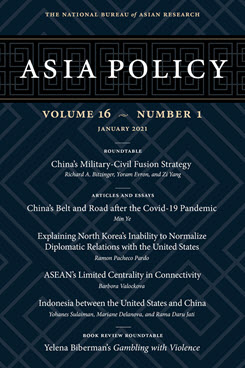ASEAN’s Limited Centrality in Connectivity
Managing Infrastructure Competition between China and Japan
This article examines the concept of ASEAN centrality in connectivity and assesses the role and effectiveness of ASEAN in managing infrastructure financing competition between China and Japan.
EXECUTIVE SUMMARY
MAIN ARGUMENT
Scholars have recommended that ASEAN establish a multilateral coordination mechanism, such as an infrastructure forum, to manage the geopolitics of China’s and Japan’s often competing infrastructure initiatives. Thus far, ASEAN has not been able to set up such a mechanism due to its limited centrality in connectivity issues. Instead, the grouping sets the scope for connectivity, formulating broad policies such as the Master Plan on ASEAN Connectivity 2025. ASEAN’s confinement to this role and the lack of an institutional framework have been beneficial to member states, allowing them to prioritize and implement infrastructure projects based on their individual needs. They have developed their own bargaining styles and preferences in dealing with larger powers and connectivity-related issues. Any potential for ASEAN to strengthen its centrality in connectivity is therefore hampered less by external powers than by its own member states and stakeholders involved in infrastructure development. However, while ASEAN’s centrality in connectivity is limited, it is not insignificant. The grouping still drives compatibility and convergence between the competing infrastructure initiatives and gradually unites the interests of recipients and donors.
POLICY IMPLICATIONS
- An institutionalized infrastructure forum between ASEAN, China, and Japan is not an appropriate solution to manage infrastructure rivalry. Negotiations between China and Japan would be difficult to conduct multilaterally, and the differences between official consensus and actual practice may be substantial.
- ASEAN should focus instead on boosting internal coherence and coordination, sharing best practices for the negotiation and implementation of measures to improve connectivity, and helping Chinese and Japanese companies adjust their business models to contribute to the social and economic development of ASEAN and its member states.
- A suitable and consistent risk-sharing mechanism needs to be put in place to make infrastructure projects financially sustainable and thus facilitate deeper collaboration among ASEAN, its external partners, and internal stakeholders.
Barbora Valockova is a PhD candidate in the Public Policy and Global Affairs Programme of the School of Social Sciences at Nanyang Technological University (Singapore). Her research focuses on international political economy, international relations, ASEAN, and East Asia. Before pursuing her PhD, she worked as an Asia-Pacific infrastructure analyst and a trainee at the European Commission.
About Asia Policy
Asia Policy is a peer-reviewed scholarly journal presenting policy-relevant academic research on the Asia-Pacific that draws clear and concise conclusions useful to today’s policymakers. Asia Policy is published quarterly in January, April, July, and October and accepts submissions on a rolling basis. Learn more


